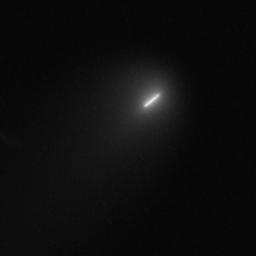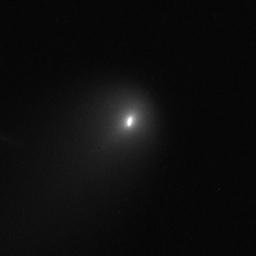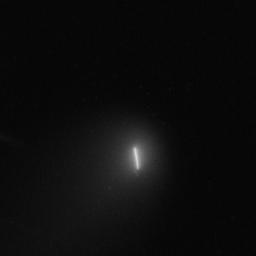
 |
| Comet C/2012 S1 (ISON) |
|---|
| Hubble, 2013 Apr 30 |
| Combined 3-exposure image |
Some bloggers have noted that the Comet C/2012 S1 (ISON) Hubble images have some surprising features. Here we briefly explain the origin of the image structures.
Quick summary: The image is the result of combining 3 exposures that produce the 3 components, and the shapes are produced by the combined motion of the Hubble telescope and the comet. The images look exactly as expected.
The image from April 30, 2013 (released on July 16, 2013) using the F606W filter has attracted the most attention. That image (shown above) is the average of 3 separate Hubble exposures. The 3 exposures are available individually for display or download from the web page, as is the combined image. The table below shows the image of the comet in each of the 3 exposures along with information about the exposures.
| Exposure 1 | Exposure 2 | Exposure 3 |
|---|---|---|
| hlsp_ison_hst_wfc3_130430a_f606w_v1 | hlsp_ison_hst_wfc3_130430c_f606w_v1 | hlsp_ison_hst_wfc3_130430e_f606w_v1 |
| Start time (UT): 2013-04-30 03:35:43 | 2013-04-30 03:56:15 | 2013-04-30 04:16:47 |
| Exposure: 440 seconds | 440 seconds | 440 seconds |
 |
 |
 |
You can see that the 3 parts of the structure in the combined image result from the 3 different exposures. The comet itself does not have 3 pieces. They are an artifact that results from adding up the separate exposures.
The comet does not look the same in each exposure because both the comet and the Hubble telescope are moving during the exposure. The comet is blurred, just as a picture taken out the window of a moving car will be blurred. For this image the Hubble telescope was pointing very steadily and accurately at the background stars and galaxies rather than tracking the comet.
In this case, the largest part of the blurring is due to the motion of Hubble itself rather than the motion of the comet. Hubble is orbiting the Earth every 95 minutes. The third exposure ended 46 minutes after the start of the first exposure. During that time the telescope moved from one side of its orbit to the other, a distance of about 8000 miles (~13,000 km). Because the comet is relatively nearby (compared with the distant stars and galaxies), its apparent position among the stars changes due to the different viewing position. This effect is known as parallax. It is expected when observing Solar System targets, and can produce very obvious motion or blurring in images as Hubble whips around the Earth.
There is a nice discussion of the effects of parallax on the Comet ISON images in this YouTube video. It includes detailed modeling of the parallax in these particular images and shows that the observed pattern is exactly what is expected. Another YouTube video shows the effects of combining multiple exposures.
More information about the comet can be found at the Hubblesite ISON blog. There is a specific blog post about making the Hubble color image of Comet ISON.
archive@stsci.edu